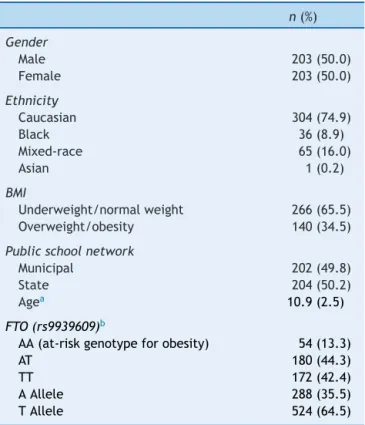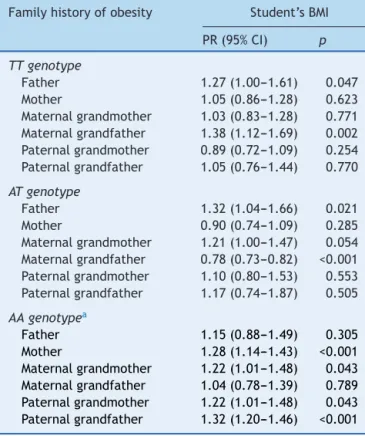www.jped.com.br
ORIGINAL
ARTICLE
Association
between
overweight
and
obesity
in
schoolchildren
with
rs9939609
polymorphism
(FTO)
and
family
history
for
obesity
夽
,
夽夽
Cézane
Priscila
Reuter
a,b,∗,
Miria
Suzana
Burgos
b,
Joana
Carolina
Bernhard
b,
Debora
Tornquist
b,
Elisa
Inês
Klinger
b,
Tássia
Silvana
Borges
c,
Jane
Dagmar
Pollo
Renner
b,
Andréia
Rosane
de
Moura
Valim
b,
Elza
Daniel
de
Mello
aaUniversidadeFederaldoRioGrandedoSul,PortoAlegre,RS,Brazil bUniversidadedeSantaCruzdoSul,SantaCruzdoSul,RS,Brazil cUniversidadeLuteranadoBrasil,Canoas,RS,Brazil
Received14September2015;accepted25November2015 Availableonline4May2016
KEYWORDS
Obesity; Genetic; Child; Adolescent
Abstract
Objective: Todeterminetheassociationbetweenoverweight/obesityinschoolchildrenwith
FTOrs9939609polymorphism(fatmassandobesityassociated)andfamilyhistoryofobesity.
Methods: Cross-sectionalstudycomprisingasampleof406childrenaged7---17yearsinacityin
southernBrazil.Overweight/obesityinschoolchildrenwasassessedbybodymassindex(BMI), andfamilyhistoryofobesitywasself-reportedbyparents.Polymorphismgenotypingwas per-formedbyrealtimePCR(polymerasechainreaction).Theassociationbetweenthenutritional statusofschoolchildrenwiththepresenceoffamilyobesity,stratifiedbypolymorphism geno-types(AA[at-riskforobesity],AT,andTT),wasassessedbyprevalenceratiovalues(PR)through Poissonregression.
Results: Among schoolchildren with the AA genotype, 57.4% had overweight/obesity; the
percentage was lower for the ATandTT genotypes (33.1% and28.9%, respectively). Over-weight/obesity inschoolchildren wasassociated with afamilyhistoryofobesity, especially amongchildrenwiththeAAgenotype.Theprevalencewashigheramongthosewithanobese mother(PR:1.28;p<0.001),obesematernalorpaternalgrandmother(PR:1.22;p=0.047),and obesepaternalgrandfather(PR:1.32;p<0.001).
夽
Pleasecitethisarticleas:ReuterCP,BurgosMS,BernhardJC,TornquistD,KlingerEI,BorgesTS,etal.Associationbetweenoverweight andobesityinschoolchildrenwithrs9939609polymorphism(FTO)andfamilyhistoryforobesity.JPediatr(RioJ).2016;92:493---8.
夽夽
StudyconductedatthePostgraduatePrograminHealthPromotion,UniversidadedeSantaCruzdoSul(UNISC),SantaCruzdoSul,RS, Brazil;andPostgraduatePrograminChildandAdolescentHealth,UniversidadeFederaldoRioGrandedoSul(UFRGS),PortoAlegre,RS, Brazil.
∗Correspondingauthor.
E-mail:cezanereuter@unisc.br(C.P.Reuter).
http://dx.doi.org/10.1016/j.jped.2015.11.005
0021-7557/©2016SociedadeBrasileiradePediatria.PublishedbyElsevierEditoraLtda.ThisisanopenaccessarticleundertheCCBY-NC-ND
Conclusions: ThereisanassociationbetweentheAAgenotypeofrs9939609polymorphismand BMIamongschoolchildren.Theassociationbetweenoverweight/obesityinschoolchildrenwith afamilyhistoryofobesitywasfoundmainlyamongstudentswiththeAAgenotype.
©2016SociedadeBrasileiradePediatria.PublishedbyElsevierEditoraLtda.Thisisanopen accessarticleundertheCCBY-NC-NDlicense(http://creativecommons.org/licenses/by-nc-nd/ 4.0/).
PALAVRAS-CHAVE
Obesidade; Genética; Crianc¸a; Adolescente
Associac¸ãoentresobrepesoeobesidadeemescolarescomopolimorfismors9939609 (FTO)ehistóricofamiliardeobesidade
Resumo
Objetivo: Verificarseexisterelac¸ãoentreosobrepeso/obesidadedeescolarescomo
polimor-fismors9939609,dogeneFTO(fatmassandobesityassociated)ecomohistóricofamiliarde obesidade.
Métodos: Estudotransversalcompostoporumaamostrade406escolares,desetea17anos,
deummunicípiodosuldoBrasil.Osobrepeso/obesidadedosescolaresfoiavaliadopormeiodo índicedemassacorporal(IMC)eohistóricofamiliardeobesidadeporquestõesautorreferidas pelospais.Agenotipagemdopolimorfismo foifeitaporPCR(polymerasechainreaction)em temporeal.Aassociac¸ãoentreoestadonutricionaldosescolarescomapresenc¸adeobesidade familiar,estratificadapelosgenótiposdopolimorfismo(AA---riscoparaobesidade,ATeTT),foi avaliadapelosvaloresderazãodeprevalência(RP),pormeiodaregressãodePoisson.
Resultados: EntreosescolarescomogenótipoAA,57,4%apresentaramsobrepeso/obesidade;
para os genótipos TT e AT, o percentual é inferior (33,1% e 28,9%, respectivamente). O sobrepeso/obesidadedoescolarassociou-secomohistóricofamiliardeobesidade, principal-menteentreosescolaresportadoresdogenótipoAA,foisuperiorentreosqueapresentammãe obesa(RP:1,28;p<0,001),avómaternaepaternaobesas(RP:1,22;p=0,047)eavôpaterno obeso(RP:1,32;p<0,001).
Conclusões: Hárelac¸ãoentreogenótipoAA,dopolimorfismors9939609,comoIMCdos
esco-laresavaliados. Arelac¸ãoentresobrepeso/obesidadedoescolarcomohistórico familiarde obesidadefoiencontrada,principalmente,entreosescolarescomogenótipoAA.
©2016SociedadeBrasileiradePediatria.PublicadoporElsevierEditoraLtda.Este ´eumartigo OpenAccesssobumalicenc¸aCCBY-NC-ND(http://creativecommons.org/licenses/by-nc-nd/4. 0/).
Introduction
Obesityisamultifactorialcondition,determinedby environ-mentaland geneticfactors,andis a facilitator ofseveral other diseases.1,2 Associated with cardiovascular diseases
and metabolic disorders, conditions previously observed mostlyin adults,childhood obesity has currently become amajor publichealth issue.3 Some fat mass and
obesity-associated(FTO)polymorphismshavebeenassociatedwith fat mass and obesity, especially the rs9939609 polymor-phism,withincreasedrisk for obesity incarriers of allele A.1 Each copy of allele A with the rs9939609
polymor-phismisassociatedwithanincreaseof0.4kg/m2inBMIand
higherchance (1.31-foldincrease) of developing obesity.4
Berentzen et al.5 and Cecil et al.3 found an association
between a higher percentage of fat and the presence of AAgenotypeinDanishadultsandScottishchildren, respec-tively. Berentzen et al.5 observed that individuals from
DenmarkhomozygousforalleleAaremorelikelyto experi-enceanincreaseof10kgoffatmass(1.3-foldhigherchance) whencomparedtocarriersoftheTTgenotype.
The FTO gene is expressed in the arcuate nucleus of the hypothalamus, a relevant region for appetite behav-ior, having an effect on homeostasis. Although the FTO gene functions and pathways are unknown, analysis of itsstructure hasshown it is involved in post-translational
modification, repairof deoxyribonucleic acid(DNA, which protectsthegenomefromdamagethatleadstomutations), andfattyacidmetabolism.2,6TheFTOwasidentifiedforthe
firsttime asa susceptiblegenetoobesity in twogenome studies.7 Sincethen, studieshave focused onthe
associa-tionof theFTOgenewithexcessivefat accumulationand itsinteractionwithbehavioralfactors.2
Conversely, it is known that obesity is a multifacto-rial condition with a strong lifestyle influence and that physical activity acts as aprotective factor, regardless of rs9939609 polymorphism genotype.2 In addition to
physi-cal activity,inadequate eatinghabits areassociated with the development of obesity, and parents’ behavior has great influenceon theconsumption of high-calorie foods. Therefore, parents are role models for their children’s behavior, influencing their food preferences since early childhood.8
Thus, this study aimed to verify whether there is an association between overweight/obesity of children with rs9939609polymorphism oftheFTO geneandtheirfamily historyofobesity.
Methods
of Santa Cruz do Sul,state of Rio Grande do Sul, Brazil. At thestart ofthe study,aminimumof 392 studentswas estimatedfor anerrorof 5%andconsideringaprevalence of overweight and obesity of 30%9 for the sample to be
representative of the municipality.10 The students whose
freeand informedconsentformwassigned byparents or guardianswereincludedin thestudy.Initially,thesample had 420 students; however, 14 parents/guardians did not completethequestionnaireonfamilyhistoryofobesityand wereexcluded.
ThestudywaspreviouslysubmittedtotheEthics Commit-teeonHumanResearchofUniversidadedeSantaCruzdoSul (UNISC),andwasapprovedunderprotocolNo.2525/10.All parentsor guardiansoftheschoolchildrensignedthe con-sent formauthorizingparticipationinthe study.The form providedinformation onthe purposeof the study and its procedures,aswellaspossiblediscomfortsandbenefitsof thestudy.
Anthropometric assessment of the schoolchildren com-prised the body mass index (BMI), calculated using the weight and height values, which were measured through a scale andstadiometer (Welmy, Santa West Barbara,SP, Brazil), by a Physical Education teacher experienced in thistypeofassessment,performedwiththeschoolchildren wearinglightclothingandbarefoot.Atthebeginningofeach evaluationday,thescalewascalibrated.Subsequently,the formula:BMI=weight/height2wasapplied.
BMIwasclassifiedaccordingtothepercentilecurvesof theWorld HealthOrganization,11 according togender and
age, considering overweight/obesity as ≥85th percentile. Familyhistoryofobesitywasassessedthroughself-reported questions by the parents. The questionnaire contained a box for parents toindicate withan ‘‘X’’ thepresence of obesityinthefollowingfamilymembers:father,mother, sib-lings,paternalgrandfather,paternalgrandmother,maternal grandfather,andmaternalgrandmother.Obesityinsiblings wasnot included in the models,asit wasnot associated withchildobesityandadolescents.Obesityforeachfamily memberwasclassifiedas‘‘present’’whentheboxhadthe ‘‘X’’mark,or‘‘absent,’’withoutthismark.
The choiceofthers9939609polymorphism(T>A)ofthe FTOgenewasmadethroughallelefrequencysearchforthe Caucasian population, as the study population is of Ger-mandescent.12ThestudywascarriedoutusingtheHapMap
data(International HapMap Project). Of thetotal number of schoolchildren, 74.9%were Caucasians. This fact, self-reportedbythestudents,wasusedtoadjusttheanalyses involvingthers9939609polymorphism.
Blood collection was carried out at the Laboratory of ExerciseBiochemistryofUniversidadedeSantaCruzdoSul, followingthebiosafetystandards.DNAwasextractedfrom wholebloodinvialscontainingEDTA,usingcommercialkits fromQiagen (QIAamp DNA BloodMini Kit; QiagenTM,
Ger-many).Subsequently,theDNAwasquantifiedinQubit® 2.0
Fluorometer(Invitrogen,CA,USA)anddilutedtothe neces-saryconcentration.Thereal-timepolymerasechainreaction (PCR)techniquewasusedforthers9939609polymorphism genotyping using 96-well plates.The reactions were per-formed induplicateusinga10Lsample containing10ng
of genomic DNA. TaqMan probes were used,labeled with theVIC/FAMfluorophores(AppliedBiosystems,CA,USA)in StepOnePlusequipment(AppliedBiosystems,CA,USA).
Datawereentered and analyzedusing SPSS(IBMCorp. IBM SPSS Statistics for Windows, Version 23.0. NY, USA), usingdescriptivestatistics(frequencyandpercentage).The associationbetween thegenotypesofthe rs9939609 poly-morphismwithBMIofschoolchildrenandfamilyhistoryof obesitywastested usingthechi-squared test;differences wereconsidered significant when p<0.05. Poisson regres-sionwasusedtotesttheassociationbetweenthestudent’s BMI (dependent variable considering underweight/normal weightversusoverweight/obesity)withafamilyhistoryof obesity,stratifiedbythethreegenotypesofthers9939609 polymorphism(TT, AT,andAA).The analysiswasadjusted for the student’s ethnicity. The Hardy---Weinberg equilib-rium was tested using the GraphPadPrism® 5.0 software
(GraphPadSoftware, CA, USA), considering p>0.05 when comparingtheexpectedvalueswiththeobservedvalues.
Results
Table1 shows thesample characteristics, which are simi-larregardinggenderandschoolnetwork.Thepercentageof studentswithoverweight/obesitywas34.5%.The distribu-tionofgenotypes(AA,AT,andTT)andallelefrequency(A alleleand Tallele)ofthe rs9939609polymorphism ofthe FTO geneindicates thatthe data was in Hardy---Weinberg
Table1 Samplecharacterization. SantaCruzdoSul,RS, Brazil,2012.
n(%)
Gender
Male 203(50.0)
Female 203(50.0)
Ethnicity
Caucasian 304(74.9)
Black 36(8.9)
Mixed-race 65(16.0)
Asian 1(0.2)
BMI
Underweight/normalweight 266(65.5)
Overweight/obesity 140(34.5)
Publicschoolnetwork
Municipal 202(49.8)
State 204(50.2)
Agea 10.9(2.5)
FTO(rs9939609)b
AA(at-riskgenotypeforobesity) 54(13.3)
AT 180(44.3)
TT 172(42.4)
AAllele 288(35.5)
TAllele 524(64.5)
BMI, body mass index; FTO, fat mass and obesity-associated gene.
a Expressedasmean(standarddeviation).
b Significance level, according to the chi-squared test for
Table2 Associationbetweenthegenotypesofrs9939609polymorphism,student’sBMI,andfamilyhistoryofobesity.
Student’sBMIclassification
Underweight/normalweight Overweight/obesity p
n(%) n(%)
rs9939609polymorphism(FTO)
AAgenotypea(n=54) 23(42.6) 31(57.4)
ATgenotype(n=180) 128(71.1) 52(28.9) 0.001
TTgenotype(n=172) 115(66.9) 57(33.1)
Father
Yes(n=16) 5(31.3) 11(68.8) 0.003
No(n=390) 261(66.9) 129(33.1)
Mother
Yes(n=31) 18(58.1) 13(41.9) 0.364
No(n=375) 248(66.1) 127(33.9)
Maternalgrandmother
Yes(n=28) 13(46.4) 125(33.1) 0.028
No(n=378) 253(66.9) 15(53.6)
Maternalgrandfather
Yes(n=13) 6(46.2) 7(53.8) 0.135
No(n=393) 260(66.2) 133(33.8)
Paternalgrandmother
Yes(n=22) 13(59.1) 9(40.9) 0.514
No(n=384) 253(65.9) 131(34.1)
Paternalgrandfather
Yes(n=10) 4(40.0) 6(60.0) 0.086
No(n=396) 262(66.2) 134(33.8)
BMI,bodymassindex.
aAt-riskgenotypeforobesity.
equilibrium,i.e.,the observed valuesweresimilartothe expected(p=0.955).
Table 2 shows a significant association between the student’s BMI with the at-risk genotype for obesity (AA) of the rs9939609 polymorphism. Thus, the schoolchildren withthe AA genotype have a higher percentage of over-weight/obesity(57.4%)whencomparedtothechildrenwith theAT(28.9%)andTT(33.1%)genotypes.Moreover,the pres-enceofobesityinthefatherandthematernalgrandmother were associated with the student’s overweight/obesity (p=0.003andp=0.028,respectively).
In a regression model, the association between the schoolchildren’sBMI with a family history of obesity was identifiedmainly instudentswiththeat-riskgenotype for obesity(AA)for thers9939609 polymorphism(FTO).Thus, theprevalence ofobesity inthe studentsis higheramong those with an obese mother (PR: 1.28; p<0.001), obese maternal and paternal grandmother (PR: 1.22; p=0.047), andobesepaternalgrandfather(PR:1.32,p<0.001).Among thestudentswiththeTTandATgenotypes,anassociation wasfoundbetweenschoolchildren’soverweight/obesityand anobesefatherandobesematernalgrandfather(Table3).
Discussion
This study showed a significant association between the genotypes of the rs9939609 polymorphism and BMI;
the percentage of overweight and obesity in the at-risk genotype forthiscondition washigher(57.4%) when com-paredwiththeTT(33.1%)andAT(28.9%)genotype.Similar results were found in the study by Cecil et al.,3 with 97
prepubertalstudentsfromScotlandaged4---10years,which foundthattheAallelewasassociatedwithBMI(p=0.003) andincreasedfatmass(p=0.01).
The study by Wardle et al.,13 with 131 children aged
between4and5years,withoverweight/obesity,observed the at-riskgenotype for obesity(AA) in18% of their sam-ple,althoughnoassociationwasfoundwithBMI,andthose withthe highest percentageof fat werethe AAgenotype carriers. Liu et al.14 observed an association of BMI with
rs9939609 polymorphism (FTO), both among young Euro-peansandamongyoungAfricanAmericans.Inastudywith 289subjectsaged6---19years,individualswithatleastone AallelehadsignificantlyhigherBMIandfatmass.15
Further-more,inChinesechildrenandadolescents,anincreasedrisk forobesitywasfoundinsubjectswithAAorATgenotypes, when compared withsubjects withthe TTgenotype.16 In
anotherstudy,carriedoutin3503childrenandadolescents fromBeijing,China,anassociationwasfoundbetweenthe rs9939609polymorphismandobesity,inwhicheachAallele wasassociatedwithanincreaseof0.79inBMI.17
Table3 Associationbetweenthestudent’sBMIandfamily historyofobesity,accordingtothegenotypesofrs9939609 polymorphism.
Familyhistoryofobesity Student’sBMI
PR(95%CI) p
TTgenotype
Father 1.27(1.00---1.61) 0.047
Mother 1.05(0.86---1.28) 0.623
Maternalgrandmother 1.03(0.83---1.28) 0.771 Maternalgrandfather 1.38(1.12---1.69) 0.002 Paternalgrandmother 0.89(0.72---1.09) 0.254 Paternalgrandfather 1.05(0.76---1.44) 0.770
ATgenotype
Father 1.32(1.04---1.66) 0.021
Mother 0.90(0.74---1.09) 0.285
Maternalgrandmother 1.21(1.00---1.47) 0.054 Maternalgrandfather 0.78(0.73---0.82) <0.001 Paternalgrandmother 1.10(0.80---1.53) 0.553 Paternalgrandfather 1.17(0.74---1.87) 0.505
AAgenotypea
Father 1.15(0.88---1.49) 0.305 Mother 1.28(1.14---1.43) <0.001 Maternalgrandmother 1.22(1.01---1.48) 0.043 Maternalgrandfather 1.04(0.78---1.39) 0.789 Paternalgrandmother 1.22(1.01---1.48) 0.043 Paternalgrandfather 1.32(1.20---1.46) <0.001
BMI,bodymassindex;Poissonregressionconsideringtwo varia-bles(underweight/normalweight versusoverweight/obesity), adjustedforethnicity; familyhistory ofobesity:theabsence ofthisconditionwasconsideredasreference;PR,prevalence ratio;95%CI,95%confidenceinterval.
a At-riskgenotypeforobesity.
todeterminethe ageat whichthisassociation isevident, observedthatthisassociationdidnotappearuntilthe chil-dren reached 12---14 years.Afterthis age, theassociation increasedinthe femalegender between15and 18years, butnotinthemalegender.Inasubgroupthatwas followed-up,theassociationofrs9939609withBMIandobesitywere observedonlysixyearslater,andinthefemalegender,18in
agreementwiththestudy ofHenriksson etal.,19 inwhich
therewasnors9939609associationwithfatmassinthefirst twelveweeksoflife.
InthestudybySilvaetal.,20carriedoutwith348Brazilian
childrenwhowereevaluatedatages1,4,and8years,no differenceswereobservedatage1yearbetweenthemean BMIandgenotypes. Asignificant association wasobserved betweenAAgenotypeandhighermeanBMIat4years,and attheageof8years,individualswiththeAAgenotypehad highermeanBMIandsumofskinfoldthickness.
Inpopulationsoftheoceanicislands(Polynesia,Malaysia, andMicronesia),noassociationwasfoundbetweentheAA, TT,andAT alleleswithBMI,and73%ofthe subjectswere obese.21Similarly,inastudywithstudentsfromQueretaro
(Mexico),noassociation wasobservedbetweenthealleles andoverweightormetabolicriskindicators.22
ThestudybyLopez-Bernejoetal.23foundnosignificant
differencein bodyfat atbirthinbabieswiththeAallele.
After13days,itwasobservedthatbabieshomozygousfor the A allele had higher fat mass. In the study by Solak etal.,24 therewasnosignificant association between the
rs9939609 genotype of the FTO gene and anthropometric indicators(BMI,WHR,andbodycomposition).Inthestudy bySouzaetal.,25 withBrazilianchildren andadolescents,
nosignificantassociationwasfoundbetweentheFTOgene andanthropometricandmetabolicparameters,aresultthat canbeattributedtothemiscegenationoftheBrazilian pop-ulationandethnicheterogeneity.
Currently,it is notentirely known howthe A alleleof thers9939609polymorphisminfluencestheaccumulationof body fat. It is suggested that, because of its role in the hypothalamusthroughdirectconnectiontoappetitecontrol andfataccumulation,thereisastimulationinthisregion, resultinginfatuselimitationandsparing.2
Ina studyof 289young individualsaged6---19 years,it wasobserved thatsubjects withone or twoA alleles (AT orAA)hadmorefrequentlossofcontroleatingand prefer-encefor foodswithhigherfatcontent.15 Similarly,Wardle
etal.13observedthatchildrenwiththeTTgenotypeateless
thanchildrenwiththeAAgenotype.AstudyofChinese chil-drenandadolescentsshowedthatwhile subjectswiththe TTgenotypehadapreferenceforaplant-baseddiet,those withtheAA genotype hada preference for a meat-based diet.16
Wahlén et al.26 suggested an association between the
rs9939609 polymorphism and the cellular metabolism of fats,in whichcarriersoftheAT allelehadhigherglycerol releasefromadipocytesandagreaterconcentrationof glyc-erolinplasmathansubjectswiththeAAallele,indicating thatcarriersoftheATallelehaveahigherdegradationof lipids.
Inthe present study,it wasobservedthat the associa-tionbetweenthestudents’BMIandfamilyhistoryofobesity wasfoundmainlyamongchildrenandadolescentswiththe at-riskgenotypeforobesity(AA)ofthers9939609 polymor-phism. Factors associated with overweight/obesity were: anobesemother(PR:1.28;p<0.001),obesematernaland paternalgrandmother(PR:1.22;p=0.047)andobese pater-nalgrandfather(PR: 1.32;p<0.001).Lee etal.27 indicate
thatgeneticpredispositionplays an importantrolein the familydescent,withtheriskofobesityinapersonwhohas anobesefirst-degreerelativevaryingfrom1.5to5,when comparedtoanindividualwhohasonlyfirst-degreerelatives withnormalweight.Conversely,Mustelinetal.28 pointout
thatexposuretodifferentenvironments,forinstance,ahigh levelofphysicalactivity,canmodifytheinheritablelevels ofobesity.Intheirstudy,exposuretophysicalactivity signif-icantlymodifiedBMI.InschoolchildrenfromSantaCruzdo Sul,RS,Brazil,thers9939609polymorphismwasassociated withoverweight and obesity, also showing an association withcardiorespiratoryfitnesslevels.29
childhoodobesity trends, asthey influence eating behav-iorsandpracticeofphysicalactivity.30 Thesevariablescan
influencetheassociationbetweenthepolymorphismandthe clinicalphenotypeofobesity,consideringthisisa multifac-torialcondition.
The authors conclude that there is a significant asso-ciation between the risk genotype for obesity (AA) of thers9939609(FTO)polymorphismwiththestudent’sBMI. Moreover, the association between overweight/obesity of students with a family history of obesity was identified mainlyinstudentswiththeAAgenotype.
Funding
UniversidadedeSantaCruzdoSul(UNISC).
Conflicts
of
interest
Theauthorsdeclarenoconflictsofinterest.
References
1.LuisDA,AllerR,CondeR,IzaolaO,FuenteB,GonzálezSagrado M, et al. Relación del polimorfismo rs9939609 del gen FTO com factores de riesgo cardiovascular y niveles de adipoc-itoquinas en pacientes com obesidad mórbida. Nutr Hosp. 2012;27:1184---9.
2.LimaWA,GlanerMF,TaylorAP.Fenótipoda gordura,fatores associadoseopolimorfismors9939609dogeneFTO.RevBras CineantropomDesempenhoHum.2010;12:164---72.
3.Cecil JE, Tavendale R, Watt P, Hetheringnon MM, Palmer CNA. Anobesity-associated FTO gene variant and increased energy intake in children. N Engl J Med. 2008;359: 2558---66.
4.FreathyRM,Timpson NJ,LawlorDA,PoutaA, Ben-ShlomoY, RuokonenA,et al.CommonvariationintheFTOgenealters diabetes-relatedmetabolictraitstotheextentexpectedgiven itseffectonBMI.Diabetes.2008;57:1419---26.
5.BerentzenT,KringSI,HolstC,ZimmermannE,JessT,HansenT, etal.Lackofassociationoffatness-relatedFTOgenevariants withenergyexpenditureorphysicalactivity.JClinEndocrinol Metab.2008;93:2904---8.
6.Apalasamy YD, Ming MF, Rampal S, Bulgiba A, Mohamed Z. Genetic association of SNPs in the FTO gene and predispo-sition to obesity in Malaysian Malays. Braz J Med Biol Res. 2012;45:1119---26.
7.VimaleswaranKS,LiS,ZhaoJH,LuanJ,BinghamSA,KhawK, etal.Physicalactivityattenuatesthebodymassindex--- increas-inginfluenceofgeneticvariationintheFTOgene1---3.AmJClin Nutr.2009;90:425---42.
8.AnzmanSL,RollinsBY,BirchLL.Parentalinfluenceonchildren’s earlyeatingenvironmentsandobesityrisk:implicationsfor pre-vention.IntJObes(Lond).2010;34:1116---24.
9.Flores LS, Gaya AR, Petersen RD, Gaya A. Tendência do baixopeso,sobrepesoeobesidadedecrianc¸aseadolescentes brasileiros.JPediatr(RioJ).2013;89:456---61.
10.Christensen LB. Experimental methodology. 2nd ed. Boston: Allyn/Bacon;1980.
11.World Health Organization. Growth reference data for 5---19 years; 2007. Available from: http://www.who.int/ growthref/en/[cited15.07.15].
12.CarvalhoFilhoI,MonasterioL.Immigrationandtheoriginsof regionalinequality:government-sponsoredEuropeanmigration
to southernBrazil before World War I.Reg Sci Urban Econ. 2012;42:794---807.
13.WardleJ,LlewellynC,SandersonS,Plomin R.TheFTOgene and measured food intake in children. Int J Obes (Lond). 2009;33:42---5.
14.LiuG,ZhuH,LagouV,GutinB,Stallmann-JorgensenIS,Treiber FA,etal.FTOvariantrs9939609isassociatedwithbodymass indexandwaistcircumference,butnotwithenergyintakeor physicalactivityinEuropean-andAfrican-Americanyouth.BMC MedGenet.2010;9:11---57.
15.Tanofsky-Kraff M, Han JC, Anandalingam K, Shomaker LB, ColumboKM,WolkoffLE,etal.TheFTOgeners9939609 obesity-risk allele and loss of control over eating. Am J ClinNutr. 2009;90:1483---8.
16.YangM,XuY,LiangL,FuJ,XiongF,LiuG.Theeffectsofgenetic variationinFTOrs9939609onobesityanddietarypreferencesin ChineseHanchildrenandadolescents.PLOSONE.2014;9:1---9.
17.XiB,ShenY,ZhangM,LiuX,ZhaoX,WuL,etal.Thecommon rs9939609variantofthefatmassandobesity-associatedgene isassociatedwithobesity riskinchildrenandadolescentsof Beijing,China.BMCMedGenet.2010;11:107.
18.ZhangM,ZhaoX,ChengH,WangL,XiB,ShenY,etal.Age-and sex-dependentassociationbetweenFTOrs9939609and obesity-relatedtraitsinChinesechildrenandadolescents.PLOSONE. 2014;9:e97545.
19.HenrikssonP,LöfM,SöderkvistP,ForsumE.Variationinthefat massandobesity-related(FTO)genotypeisnotassociatedwith bodyfatnessininfants,butpossiblywiththeirlength.Pediatr Obes.2014;9:112---5.
20.SilvaCF,Zandoná MR, VitoloMR, Campagnolo PD, RottaLN, AlmeidaS,etal.Associationbetweenafrequentvariantofthe FTOgeneandanthropometricphenotypesinBrazilianchildren. BMCMedGenet.2013;14:34.
21.OhashiJ,Nakka I,KimuraR, NatsuharaK, YamauchiT, Furu-sawaT,etal.FTOpolymorphismsinoceanicpopulations.JHum Genet.2007;52:1031---5.
22.Flores K, Garcia O, Caama˜no MC, Ronquillo D, Martínez G, Rosado J, et al. The presence of rs9939609 of FTO and rs17782313ofMC4Rmaynotbeassociatedwithobesity, ele-vated glucose or altered lipid profile in school children of Queretaro:preliminaryanalysis.FASEBJ.2014;28:LB336.
23.Lopez-Bernejo F, Petry CJ, Dias M, Sebastiani G, Zegher F, DungerDB,etal.TheassociationbetweentheFTOgeneandfat massinhumansdevelopsbythepostnatalageoftwoweeks.J ClinEndocrinolMetab.2008;93:1501---5.
24.SolakM,ErdoganMO,YildizSH,UcokK,YukselS,TerziES,etal. Associationofobesitywithrs1421085andrs9939609 polymor-phismsofFTOgene.MolBiolRep.2014;41:7381---6.
25.SouzaNS,MeloME,FujiwaraCT,ReinhardtHL,SantosA,Cercato C,etal.rs9939609intheFTOgeneisnotrelatedtoobesityand worstmetabolicprofileinacohortofobeseBrazilianchildren andadolescents.Obesity.2011;19:S1---234.
26.WahlénK,SjolinE,HoffstedJ.The commonrs9939609gene variant of the fat mass and obesity-associated gene FTO is relatedtofatcelllipolysis.JLipidRes.2008;49:607---11.
27.Lee JH,Reed DR, PriceRA. Familial risk ratios for extreme obesity:implicationsfor mappingbetweenobesity genes.Int JObstetRelatMetabDisorders.1997;21:935---40.
28.MustelinL,SilventoinenK,PittilainenK,RissanenA,KaprioJ. PhysicalactivityreducestheinfluenceofgeneticeffectsonBMI andwaistcircumference:astudyinyoungadultstwins.IntJ Obes.2009;33:29---36.
29.ReuterCP,ValimAR,GayaAR,BorgesTS,KlingerEI,PossueloLG, etal.FTOpolymorphism,cardiorespiratoryfitness,andobesity inBrazilianyouth.AmJHumBiol.2016;28:381---6.


